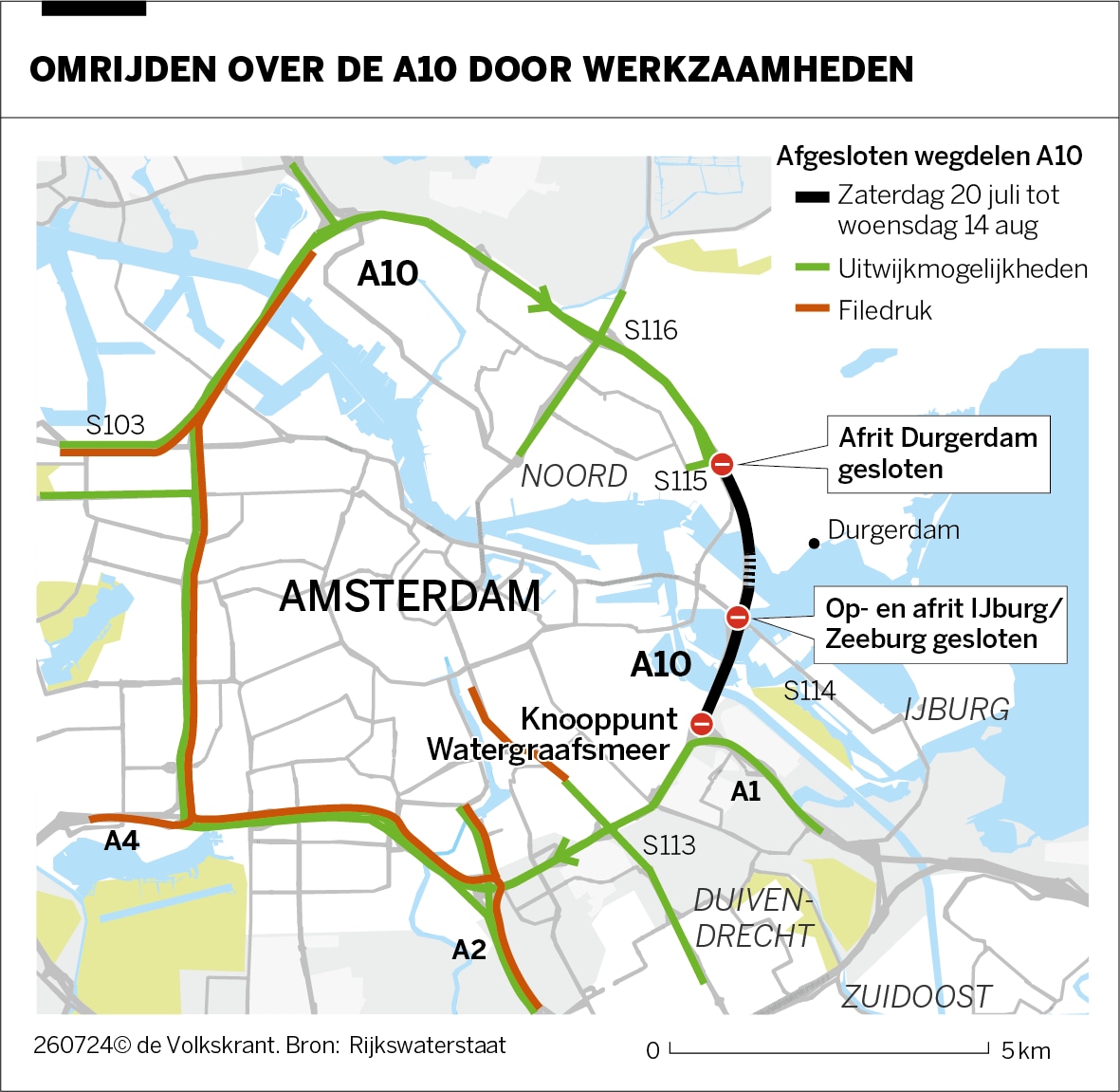Why is all maintenance performed at the same time?
VAccording to Remco de Korte, spokesman for the Rijkswaterstaat, a conscious decision was made to carry out the work on the Ring and within Amsterdam simultaneously. The best time for this is during the summer holidays, says De Korte: “In summer there is much less traffic on this stretch of road, which easily makes a difference of around two thousand cars per hour.”
According to ANWB traffic jam reader Heleen de Geest, the timing of the maintenance could certainly have been better. “People usually only go on holiday in the second week, so it would have been better if the work had started a week later.”
Impossible, says De Korte: ‘We have been working in both directions for seven weeks in total, so there will certainly be a delay of one week. If we started a week later, we would have problems again in September.’
The work and delays will irritate many Amsterdam residents and commuters. Last year things went completely wrong in Amsterdam with the “cut-off”. Then, as an experiment, the Weesperstraat was closed to traffic for six weeks; three surrounding streets were also closed to avoid traffic cuts. The city council later concluded that the experiment had yielded a lot of data, but that it was not worth repeating. However, the municipality of Amsterdam, after consulting the Rijkswaterstaat, decided to close the shortcuts again.

Could the exceptionally long traffic jams around Amsterdam have been avoided?
Rijkswaterstaat says there is no miscalculation. ‘We have models that we can use to calculate traffic levels. The Ring was planned to coincide with the construction of the Amsterdam municipality. It is better to pile it up, so people will get rid of it more quickly.’
According to Rijkswaterstaat, the extreme congestion in recent days is mainly due to accidents that also blocked the alternative route during the evening rush hour. This is not entirely surprising, says Heleen de Geest: “When there is more traffic on the road, the risk of accidents increases.”
According to Nika Haspels, spokeswoman for Amsterdam’s traffic councillor Melanie van der Horst, all parties knew it would be “a tough summer in terms of work.” That’s why the municipality, together with Rijkswaterstaat, has done everything it can to inform people in advance, the spokesperson said. ‘But our communication simply doesn’t reach everyone. And people will have to take detours anyway, so delays are part of the problem.’
‘Round ring’
The biggest road closure is on the A10 East between Watergraafsmeer and Durgerdam. Road users are therefore forced to travel in a “ring circle”: from south to west to north. However, this route has been disrupted in recent days by accidents at crucial points.
Anyone who thinks they can avoid the traffic jam by driving inland will also be in trouble: within Amsterdam itself, several major road works are also taking place. As a result, a major traffic jam occurred in Diemen on Monday and Tuesday evening, where many motorists trying to take a shortcut were stranded. The municipality of Diemen accused the municipality of Amsterdam on Tuesday evening on Facebook of not having been informed of the works.
The Amsterdam municipality denies this and stresses that the regional consultation is always carried out together with the Rijkswaterstaat. According to a spokesman for the municipality of Diemen, the message was not intended to pit the parties against each other. “What we wanted above all was to wake people up and it worked.”
Does this mean weeks of chaos?
To relieve the pressure on Diemen, additional signs will be installed to direct traffic via the Gooiseweg. This was decided on Wednesday evening by the municipalities of Amsterdam and Diemen, which together with the Rijkswaterstaat meet after each rush hour to assess the traffic situation.
The consultation has not yet led to any new solutions, which the parties involved say are not necessary. De Korte: ‘This morning there were fewer people. More and more people are on holiday and drivers now know that they have to take into account the inconvenience.’ However, the spokesman for the municipality of Diemen is doubtful: ‘I hope he is right. Yesterday it took me an hour to get to the Bijlmer, which normally takes me ten minutes.’
There are many road works going on at the same time. Is it right to look to road users for a solution?
According to mobility expert Arie Bleijenberg: “The solution to the problem of traffic jams always lies in the hands of the driver himself.” According to Bleijenberg, traffic jams actually cause road users to change their behaviour. “Motorists will have to be flexible and make a decision: can I choose another time, another destination or another means of transport?”
According to Bleijenberg, it may take a few days before everyone adjusts to the current situation. “But ultimately, traffic is like water: it seeks the path of least resistance.”